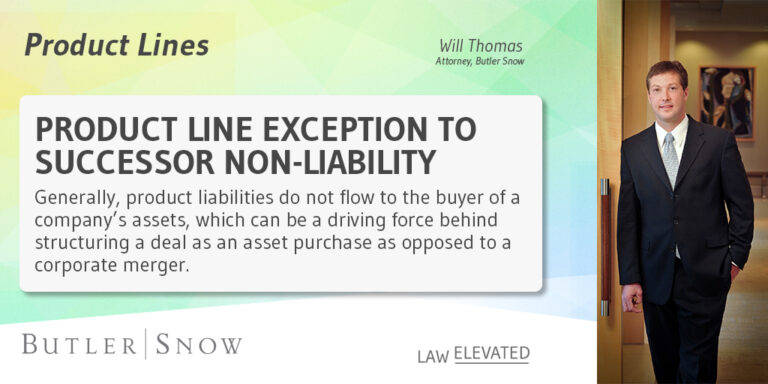Generally, product liabilities do not flow to the buyer of a company’s assets, which can be a driving force behind structuring a deal as an asset purchase as opposed to a corporate merger. There are four traditional exceptions to this general rule (1) the successor expressly or impliedly agrees to assume liability of the predecessor, (2) the transaction may be considered a de facto merger, (3) the successor is a “mere continuation” of the predecessor, or (4) the transaction was fraudulent.
In 1977 a California court created an additional exception to this general rule of non-liability of a successor following an asset purchase. Ray v. Alad Corp., 560 P.2d 3, 136 (Cal. 1977). The exception has become known as the “product line” theory and has been accepted by a minority of states across the country. Ray v. Alad Corp., 560 P.2d 3, 136 (Cal. 1977). The elements are: (1) the successor must produce the same product under a similar name; (2) the successor must have acquired substantially all of the predecessor’s assets leaving no more than a corporate shell; (3) the successor must hold itself out to the public as a mere continuation of the predecessor; and (4) the successor must benefit from the goodwill of the predecessor.
This exception is sparingly litigated despite its forty-one year history. The Mississippi Supreme Court first addressed the doctrine in 2001 but did not apply it to find liability and has not applied the exception in a single case to this day. Huff v. Shopsmith, Inc., 786 So. 2d 383, 387 (Miss. 2001). Courts generally disfavor the product line exception because it places liability on a company that did not design, sell or manufacture the product. Niccum v. Hydra Tool Corp., 438 N.W.2d 96 (Minn. 1989) (collecting 18 cases that reject the doctrine). Without a statute of repose a successor could be liable for a predecessor’s decades old products. The potential liability this theory could place on a buyer of assets could be very significant. The predecessor company could purchase a “tail insurance policy” to cover this liability but those policies may not be affordable or practical.
In a recent New Mexico product liability case the successor/defendant avoided liability under the exception. Romas v. Foam America, Inc., CV No. 15-980 CG/KRS, 2018 WL 1684327 (April 5, 2018). The plaintiff was injured by a “tar lugger,” which is a device used to move hot tar in the asphalt roofing industry. After the asset purchase the successor/defendant continued to market the predecessor’s “tar lugger” but only sold a “tar lugger” that the successor/defendant had been selling prior to the asset purchase. Because the “same product” was discontinued after the asset purchase the exception was unavailable and the claims were dismissed.
The Romas court noted that the “pillar principle of the product line exception is that the successor entity must have continued the specific product line at issue.” Id. at *5 (citing Garcia v. Coe Mfg. Co., 933 P.2d 243, 249 (N.M. 1997) (holding that the product line exception applies when “the successor continues to produce and market the same product, using the same designs, equipment, and name”); Turner v. Mudrick Mach. Works, 589 F. Supp. 771 (E.D. Pa. 1984) (declining to apply the product line exception where the successor did not continue to manufacture the product line which encompassed the machine that caused the injury); Fox v. Sunmaster Products, Inc., 821 P.2d 502, 508 (Wash. Ct. App. 1991) (declining to apply the product line exception where the successor did not continue to make the product that caused the injury, even though it continued to make its own similar product). Similarly, courts have found that the product line exception does not apply when a successor modifies or improves the subject product’s design, or when successors simply manufacture replacement parts. See, e.g., Farmex Inc. v. Wainwright, 269 Ga. 548, 501 S.E.2d 802 (1998) (finding the product line exception did not apply where the successor changed the design of the product at issue); Lundell v. Sidney Machine Tool Co., 190 Cal. App. 3d 1546 (Cal. App. 2d 1987) (finding the product line exception did not apply where the successor only supplied replacement parts for the machines at issue). Therefore, in the minority of states that have adopted the product line exception a design change and/or discontinued design is a critical defense to legacy product liability claims.
Most states in the Butler Snow’s footprint have rejected the product line exception:
| Mississippi | Huff v. Shopsmith, Inc., 786 So. 2d 383, 387 (Miss. 2001) (discussion in dicta). |
| Alabama | Brown v. Econ. Baler Co., 599 So. 2d 1, 3 (Ala. 1992) (product line argument treated as mere continuation) |
| Louisiana | Page v. Gulf Oil Co., 812 F.2d 249 (5th Cir. 1987) (recognizing Louisiana law is hostile). |
| Texas | Holden v. Capri Lighting, Inc., 960 S.W.2d 831 (Tex. App. Amarillo 1997) (refusing to recognize product line exception). |
| Tennessee | Not addressed by any case. |
| Georgia | Farmex Inc. v. Wainwright, 269 Ga. 548, 550, 501 S.E.2d 802, 804 (1998) (discussed but not adopted). |
| Virginia | Harris v. T.I., Inc., 243 Va. 63, 71, 413 S.E.2d 605, 609 (1992) (rejecting product line exception). |
| Colorado | Johnston v. Amsted Indus., Inc., 830 P.2d 1141, 1146 (Colo. App. 1992) (rejecting product line exception). |
| New Mexico | Garcia v. Coe Mfg. Co., 933 P.2d 243, 249 (N.M. 1997) (adopts product line exception). |
| New York | Semenetz v. Sherling & Walden, Inc., 7 N.Y.3d 194 (2006) (rejecting product line exception). |
